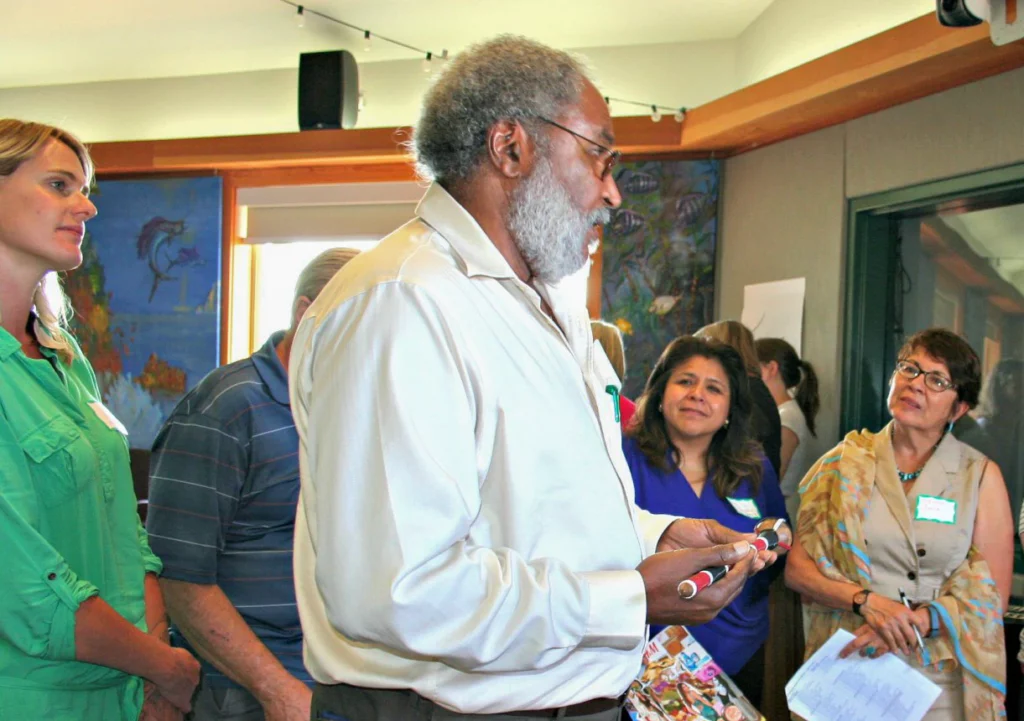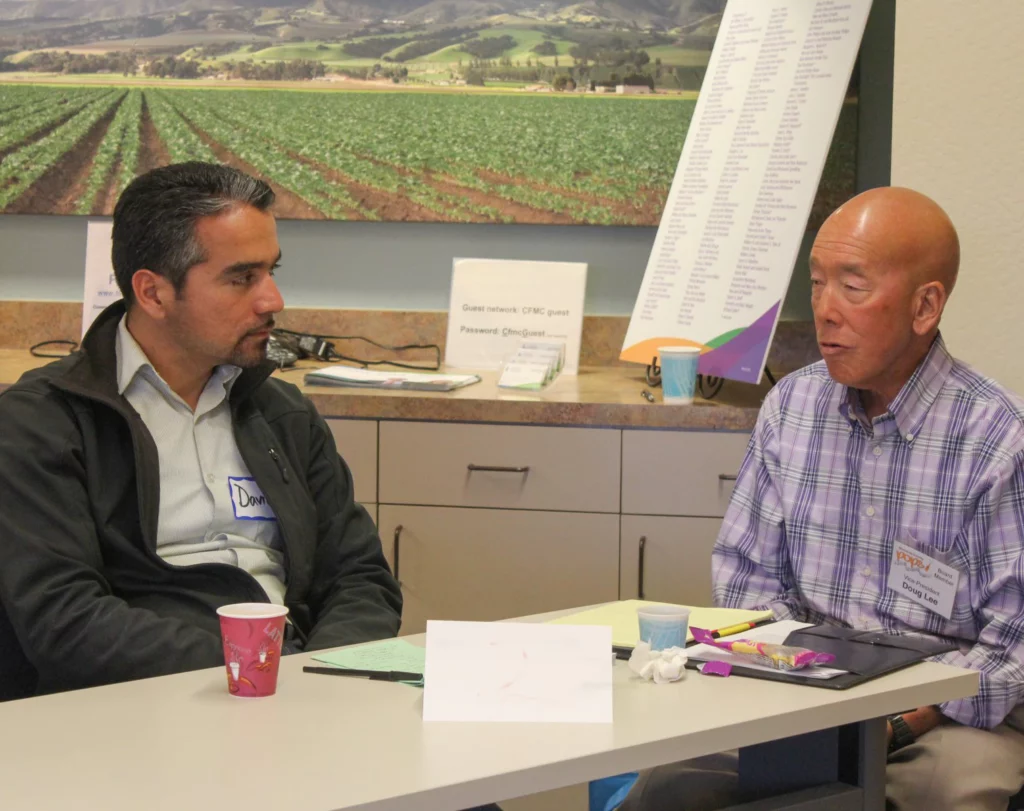The Handbook describes our approach to mentoring for small organizations. It is based on our experience with several cohorts of Community Foundation for Monterey County grantees participating in capacity building programs over the last few years, including the Community Leadership Project and Next Steps for Small Nonprofits. Our hope is that you find it useful as you design your own program or services.

You can download the entire Handbook as a PDF or read it online. We recommend reading in chapter order, but feel free to skip around!
In 2010, the Community Foundation for Monterey County launched the Community Leadership Project (CLP).* Its aim was to strengthen small or nascent nonprofit organizations in Monterey County, particularly those led by or serving communities of color, and eventually included grantees in Santa Cruz and San Benito Counties. Since many of the participating organizations were new to the concept of building capacity, the program’s designers understood early on that they would need significant and ongoing support to take advantage of the resources the initiative provided.
*The funders supporting the Community Leadership Project were the David and Lucile Packard Foundation, the James Irvine Foundation, and the William and Flora Hewlett Foundation
In thinking about how to best support the organizations, the program designers took several key understandings into consideration.
Grassroots organizations with a strong sense of mission, given the choice to invest in capacity building or in programs, will usually choose to allocate their funding to providing services to the community. Therefore, capacity-building support would need to be designated for that purpose or provided at no cost, and be an integral part of the grant program. This type of support is most effective if combined with multi-year funding for general operations.
Traditionally structured consulting or coaching relationships would not be sufficient to make the support fully accessible to the participating organizations. The organizations would need a resource person with deep experience in small or grassroots organizational development who could be a partner in this development. This person would have the flexibility to co-design the relationship based on each organization’s needs and aspirations and interact with its leaders in a mutually agreed-upon schedule and process. This person was called a “mentor,” combining the characteristics of a personal mentor with the technical assistance approach and structure usually associated with consulting or coaching relationships.
The mentor offered a sounding board; connections to resources; and supportive, non-judgmental counsel – all while supporting goals and aspirations defined by the organization. The mentor was not expected to provide all the answers to the organization’s challenges, but rather support the organization in finding their own answers.
As the concept evolved, it became clear that the mentor could help build the capacity of the organization while also helping the organization’s key staff, volunteers, and board members develop their own leadership capacities.
This approach was tested for the seven years of the CLP and was incorporated into other funding initiatives in the region. Although these initiatives included a variety of funding and capacity building approaches, the “mentor” model was primarily the same. The consultants who developed the original model continued to play a mentor role ‑ learning, refining and documenting the model as the experience unfolded.
The mentorship approach was initially conceived as a method for supporting small, grassroots, or nascent organizations, whose leaders had limited or no experience managing an organization. Some organizations had secured their 501 (c) 3 status, while others were fiscally sponsored groups.
In terms of organizational capacity, most of the organizations mentored began their work firmly grounded in their passion for improving the quality of life of people in their communities. Common strengths included:
However, the groups needed to improve their administrative capacity to manage and sustain their organizations. Common challenges included:
The mentor approach allowed these organizations to strengthen their organizational infrastructure at a pace and sequence appropriate to their specific situation and interests.
Over time, the mentors also supported more mature organizations and seasoned leaders who found the opportunity to work closely with an experienced colleague and partner very useful, particularly if the organization or the leaders where facing a significant change in direction or challenging circumstances.
Chapter 2 provides a summary of effective mentor characteristics and practices.
Chapter 1 introduced the concept of mentoring for organizations. A capacity building program based on this concept requires consideration of the characteristics of effective mentors, as well as the key practices that contribute to useful mentoring. This chapter summarizes our observations based on our experience as mentors and managers of mentors.
The mentoring for organizations process includes the following steps:
The methods used by the mentors to establish strong partnerships with the organizations revealed a set of essential practices and lessons learned. The most effective mentors:
Building organizational capacity can be challenging for any organization regardless of their stage of development, but it is particularly difficult for small or nascent organizations without the depth of experience to manage change and growth. Mentors need to bring the maturity and skill, along with an understanding of common challenges, keeping in mind that:
A successful mentorship relationship requires alignment of the mentor’s personality, values and skill with the organization’s culture and stage of development. In selecting a mentor, the organization or funding partner must look for both personal attributes and technical expertise that will be appropriate for the organization’s needs, such as:
Personal attributes and technical expertise can be learned and developed over time. A mentor development process begins with the following steps:
Chapter 3 focuses on organizational self-assessment, an important early step in the mentorship and capacity improvement planning.
In the previous chapter, we summarized the steps in organizational mentoring, characteristics of a good mentor, and effective mentoring practices. In this chapter we cover organizational assessment as an important early step for informing capacity-building goals.
An organizational self-assessment is an analysis and evaluation by the organization’s leaders and stakeholders (e.g., board members, staff, volunteers, participants, key supporters) of the organization’s direction and capacity to meet its own goals. Through the process, leaders identify shared concerns and prioritize actions.
The assessment process can be guided in one of two ways:
An assessment conducted through a facilitated discussion is designed with the following purposes:
Strategic questions to ask include:
Your organization will be…
Your organization will do …
How much do you want to grow? In what way?
Personal attributes and technical expertise can be learned and developed over time. A mentor development process begins with the following steps:
Chapter 4 will go into more detail about capacity improvement plans: creating, implementing, and monitoring plans with mentor support.
Chapter 3 provided guidance for organizational self-assessment as a way to lay the ground work for setting capacity improvement goals and plans, the subject of this chapter.
Through facilitated dialogue and reflection on the assessment results, leaders identify and prioritize the capacity improvement goals that the organization will work to achieve. The mentor supports the organization in setting goals that are grounded in the realities of the community where they work and their organization’s capacity and possibilities.
The elements of the Capacity Improvement Plan will typically include:
We’ve included a sample Capacity Improvement Plan Template in the Mentor’s Toolbox.
Once the capacity improvement plan is adopted and the organization has clear goals, the mentoring process transitions to supporting the implementation of the plan and to working alongside leaders, as they work on their own growth and development. Although the plan has specific action steps, the mentorship extends beyond the structure of the plan to address any unexpected issues that may arise for the organization and any concerns impacting the leaders. The mentor also supports the organization in amending and updating the plan as needed.
The mentoring process includes the following elements:
Additional support includes:
The Capacity Improvement Plan is a roadmap for tracking the group’s progress. At regularly scheduled meetings, the leaders and mentors review movement toward milestones based on the timeframe the group adopted for their goals. Through this review, challenges that impede progress are also identified, as well as changes in the organization and community that may require shift in direction or a modification of the plans. This may include changes in the consultant or other resources used, and funding reallocation for technical assistance. The mentor and leaders work together to review options and support the organization in making those decisions. The mentor may also provide guidance or facilitation in communicating with the funders who provided the financial support for those resources.
If the mentor is working with the group over a number of years, it is helpful to update the Organizational Assessment and Capacity Improvement Plan annually to ensure that the organization reflects on its progress and that plans remain relevant in moving the organization forward, as the organization evolves and as community conditions change.
If the mentor is working in partnership with a funder, the mentor can also play an important role in ensuring that grant applications and reports meet the required deadlines.
The mentor can also systematically track progress with a Tracking Sheet. The Tracking Sheet is a log a mentor can use to document their interaction with the groups, follow-up steps to take, resources to provide, and the group’s major milestones. It is a useful running history of the group’s path toward achieving their goals and of the lessons learned along the way by the leaders and the mentor.
Through consistent communication with leaders and by carefully monitoring the organization’s progress, the mentor will become aware of moments when it is time to consider adjusting the original capacity building direction. Those moments are commonly found when:
As the relationship between the mentor and organization ends, reflecting on and celebrating progress toward achieving the goals – and moving closer to the vision set at the beginning – provides a shot of energy and inspiration for the future. Part of the reflection can include a discussion on how the organization will continue to make capacity building part of its culture. By now, the organization will have had sufficient experience to understand and appreciate of the value of self-assessment and capacity improvement planning. They will also have learned how to access and use relevant resources – getting the help they need to support their growth.
We are also including on this site the main tools and resources used and/or created by the mentors in their work with participating organizations.

It seems we can't find what you're looking for.
Sign up to our newsletter